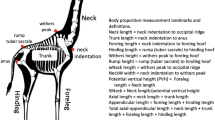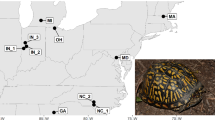Abstract
Phenotypic variation, measured as the coefficient of variation (CV), is usually larger in secondary sexual characters than in ordinary morphological traits. We tested if intraspecific differences in the CV between ornamental and non-ornamental feather traits in 67 evolutionary events of feather ornamentation in birds were due to differences in (1) the allometric pattern (slope of the regression line when regressing trait size on an indicator of body size), or (2) the dispersion of observations around the regression line. We found that only dispersion of observations around the regression line contributed significantly to total variation. A large dispersion of observations around the regression line for ornamental feathers is consistent with these characters showing condition-dependence, supporting indicator models of sexual selection more strongly than a pure Fisher process. Ornamental feathers in males demonstrated negative allometry when regressed on tarsus length, which is a measure of skeletal body size. This finding is consistent with ornamental feather traits being subject to directional selection due to female mate preferences, where large body size is less important than in male–male competition. This pattern of phenotypic variation for avian secondary sexual characters contrasts with patterns of variation for insect genitalia, supposedly subject to sexual selection, since the latter traits only differ from ordinary morphology traits in allometry coefficient. The prevailing regime of selection (directional or stabilizing) and the effects of environmental factors are proposed to account for these differences among traits.
Access this article
We’re sorry, something doesn't seem to be working properly.
Please try refreshing the page. If that doesn't work, please contact support so we can address the problem.
Similar content being viewed by others
References
Alatalo, R.V., Höglund, J. and Lundberg, A. (1988) Patterns of variation in tail ornament size in birds. Biol. J. Linn. Soc. 34, 363-374.
Andersson, M. (1982) Sexual selection, natural selection and quality advertisement. Biol. J. Linn. Soc. 17, 375-393.
Andersson, M. (1986a) Evolution of condition-dependent sex ornaments and mating preferences: sexual selection based on viability differences. Evolution 40, 804-816.
Andersson, M. (1986b) Sexual selection and the importance of viability differences: a reply. J. Theor. Biol. 120, 251-254.
Andersson, M. (1994) Sexual Selection. Princeton University Press, Princeton, NJ.
Balmford, A., Jones, I.L. and Thomas, A.L.R. (1994) How to compensate for costly sexually selected tails: the origin of sexually dimorphic wings in long-tailed birds. Evolution 48, 1062-1070.
Becker, W.A. (1984) Manual of Quantitative Genetics. 4th edn. Academic Enterprises, Pullman, WA.
Borgia, G. (1979) Sexual selection and the evolution of mating systems. In M.S. Blum and N.A. Blum (eds) Sexual Selection and Reproductive Competition in Insects. Academic Press, New York, NY, pp. 19-80.
Bulmer, M.G. (1980) The Mathematical Theory of Quantitative Genetics. Oxford University Press, Oxford, UK.
Cuervo, J.J. and Møller, A.P. (1999) Phenotypic variation and fluctuating asymmetry in sexually dimorphic feather ornaments in relation to sex and mating system. Biol. J. Linn. Soc. 68, 505-529.
Dominey, W.J. (1983) Sexual selection, additive genetic variance and the “phenotypic handicap”. J. Theor. Biol. 101, 495-502.
Eberhard, W.G., Huber, B.A., Rodríguez, R.L., Briceño, R.D., Salas, I. and Rodríguez, V. (1998) One size fits all? Relationships between the size and degree of variation in genitalia and other body parts in twenty species of insects and spiders. Evolution 52, 415-431.
Eberhard, W.G., Huber, B.A. and Rodríguez, R.L. (1999) Don't forget the biology: a reply to Green. Evolution 53, 1624-1627.
Falconer, D.S. (1989) Introduction to Quantitative Genetics. 3rd edn. Longman, New York, NY.
Fisher, R.A. (1930) The Genetical Theory of Natural Selection. Clarendon Press, Oxford, UK.
Gould, S.J. (1966) Allometry and size in ontogeny and phylogeny. Biol. Rev. Camb. Philos. Soc. 41, 587-640.
Green, A.J. (1992) Positive allometry is likely with mate choice, competitive display and other functions. Anim. Behav. 43, 170-172.
Green, A.J. (1999) Allometry of genitalia in insects and spiders: one size does not fit all. Evolution 53, 1621-1624.
Hedrick, A.V. (1988) Female choice and the heritability of attractive male traits: an empirical study. Am. Nat. 132, 267-276.
Höglund, J. (1989) Size and plumage dimorphism in lek-breeding birds: a comparative analysis. Am. Nat. 134, 72-87.
Höglund, J. and Sillén-Tullberg, B. (1994) Does lekking promote the evolution of male-biased size dimorphism in birds? On the use of comparative approaches. Am. Nat. 144, 881-889.
Iwasa, Y., Pomiankowski, A. and Nee, S. (1991) The evolution of costly mate preferences. II. “handicap principle”. Evolution 45, 1431-1442.
Kirkpatrick, M. (1982) Sexual selection and the evolution of female choice. Evolution 36, 1-12.
Kodric-Brown, A. and Brown, J.H. (1984) Truth in advertising: the kinds of traits favored by sexual selection. Am. Nat. 124, 309-323.
Kotiaho, J.S., Simmons, L.W. and Tomkins, J.L. (2001) Towards a resolution of the lek paradox. Nature 410, 684-686.
Lande, R. (1981) Models of speciation by sexual selection on polygenic characters. Proc. Natl. Acad. Sci. USA 78, 3721-3725.
Michod, R.E. and Hasson, O. (1990) On the evolution of reliable indicators of fitness. Am. Nat. 135, 788-808.
Møller, A.P. (1990) Fluctuating asymmetry in male sexual ornaments may reliably reveal male quality. Anim. Behav. 40, 1185-1187.
Møller, A.P. (1991) Sexual selection in the monogamous barn swallow (Hirundo rustica). I. Determinants of tail ornaments size. Evolution 45, 1823-1836.
Møller, A.P. (1992a) Patterns of fluctuating asymmetry in weapons: evidence for reliable signalling of quality in beetle horns and bird spurs. Proc. R. Soc. Lond. B 248, 199-206.
Møller A.P. (1992b) Parasites differentially increase the degree of fluctuating asymmetry in secondary sexual characters. J. Evol. Biol. 5, 691-699.
Møller A.P. (1996) The cost of secondary sexual characters and the evolution of cost-reducing traits. Ibis 138, 112-119.
Møller, A.P. and Cuervo, J.J. (1998) Speciation and feather ornamentation in birds. Evolution 52, 859-969.
Møller, A.P. and Höglund, J. (1991) Patterns of fluctuating asymmetry in avian feather ornaments: implications for models of sexual selection. Proc. R. Soc. Lond. B 245, 1-5.
Møller, A.P. and Pomiankowski, A. (1993a) Why have birds got multiple sexual ornaments? Behav. Ecol. Sociobiol. 32, 167-176.
Møller, A.P. and Pomiankowski, A. (1993b) Fluctuating asymmetry and sexual selection. Genetica 89, 267-279.
Nur, N. and Hasson, O. (1984) Phenotypic plasticity and the handicap principle. J. Theor. Biol. 110, 275-297.
Oakes, E.J. (1992) Lekking and the evolution of sexual dimorphism in birds: comparative approaches. Am. Nat. 140, 665-684.
Petrie, M. (1988) Intraspecific variation in structures that display competitive ability: large animals invest relatively more. Anim. Behav. 36, 1174-1179.
Petric, M. (1992) Are all secondary sexual display structures positively allometric and, if so, why? Anim. Behav. 43, 173-175.
Pomiankowski, A. (1987a) The costs of choice in sexual selection. J. Theor. Biol. 128, 195-218.
Pomiankowski, A. (1987b) The “handicap” principle does work — sometimes. Proc. R. Soc. Lond. B 127, 123-145.
Pomiankowski, A., Iwasa, Y. and Nee, S. (1991) The evolution of costly mate preferences. I. Fisher and biased mutation. Evolution 45, 1422-1430.
Pomiankowski, A and Møller, A.P. (1995) A resolution of the lek paradox. Proc. R. Soc. Lond. B 260, 21-29.
Price, T., Schluter, D. and Heckman, N. (1993) Sexual selection when the female directly benefits. Biol. J. Linn. Soc. 48, 187-211.
Rice, W.R. (1989) Analyzing tables of statistical tests. Evolution 43, 223-225.
Rowe, L. and Houle, D. (1996) The lek paradox and the capture of genetic variance by condition dependent traits. Proc. R. Soc. Lond. B 263, 1415-1421.
Sheldon, F.H. and Winkler, D.W. (1993) Intergeneric by phylogenetic relationships of swallows estimated by DNA DNA hybridization. Auk 110, 798-824.
Sibley, C.G. and Ahlquist, J.E. (1990) Phylogeny and Classification of Birds. Yale University Press, New Haven, CT.
Simmons, R.E. and Scheepers, L. (1996) Winning by a neck: sexual selection in the evolution of giraffe. Am. Nat. 148, 771-786.
Simmons, L.W. and Tomkins, J.L. (1996) Sexual selection and the allometry of earwig forceps. Evol. Ecol. 10, 97-104.
Smith, R.J. (1980) Rethinking allometry. J. Theor. Biol. 87, 97-111.
Sokal, R.R. and Rohlf, F.J. (1981) Biometry. 2nd edn. Freeman, New York, NY.
Svensson, L. (1984) Identification Guide to European Passerines. 2nd edn. L. Svensson, Stockholm, Sweden.
Taylor, P.D. and Williams, G.C. (1982) The lek paradox is not resolved. Theor. Popul. Biol. 22, 392-409.
Zahavi, A. (1975) Mate selection — a selection for a handicap. J. Theor. Biol. 53, 205-214.
Zahavi, A. (1977) The costs of honesty (further remarks on the handicap principle). J. Theor. Biol. 67, 603-605.
Zar, J.H. (1984) Biostatistical Analysis. Prentice-Hall, Englewood Cliffs, NJ.
Author information
Authors and Affiliations
Rights and permissions
About this article
Cite this article
Cuervo, J.J., Møller, A.P. Components of phenotypic variation in avian ornamental and non-ornamental feathers. Evolutionary Ecology 15, 53–72 (2001). https://doi.org/10.1023/A:1011913804309
Issue Date:
DOI: https://doi.org/10.1023/A:1011913804309




